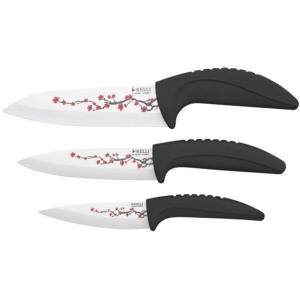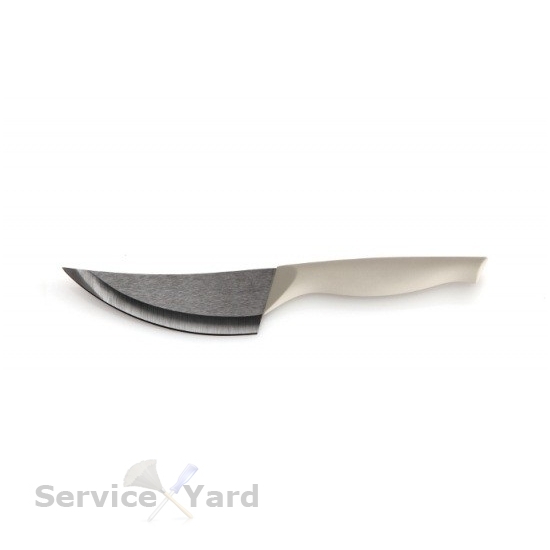How to sharpen ceramic knives?

The Japanese invention of ceramic knives is becoming more and more popular today. The quality of the novelty was appreciated by the whole culinary world. The preference for a ceramic knife is given not so much by the housewives who definitely need a sharp knife in the kitchen, but by the owners who are lazy to sharpen metal knives every week. Although ceramic knives do not require frequent sharpening, sooner or later such a problem still arises and the question arises of how to sharpen ceramic knives.
to contents ↑Ceramic knife - production features
The stylish modern look of ceramic knives attracts consumers more and more, but this is far from their only advantage. Ceramics is a very strong and reliable material, which is made from high quality zirconia powder. It is formed under high pressure and sintered in modern furnaces at temperatures above 1600 C.
 Zirconium is the second after diamond in hardness, this is its advantage and disadvantage, which is also transmitted to products from it. The product of the highest quality can only be obtained by observing the technology exactly: the longer the product is in the furnace, the better it will be, but the knives made by the accelerated process at handicraft enterprises become fragile and completely unsuitable for operation. Given even this feature, it becomes clear that sharpening ceramic knives must be done correctly and accurately.
Zirconium is the second after diamond in hardness, this is its advantage and disadvantage, which is also transmitted to products from it. The product of the highest quality can only be obtained by observing the technology exactly: the longer the product is in the furnace, the better it will be, but the knives made by the accelerated process at handicraft enterprises become fragile and completely unsuitable for operation. Given even this feature, it becomes clear that sharpening ceramic knives must be done correctly and accurately.
to contents ↑Important! Products made of high-tech material can be black and white. The strength of modern material is almost the same as some metals. This is especially true for models made of black ceramic - they are superior in strength to products made of white ceramic, since they are in the furnace for a longer time, under the influence of higher pressure and temperature. Black knives are valued higher, but they are more expensive.
The advantages of ceramic knives:
- Long service life without sharpening. Zirconium hardness allows, with careful handling, for a long time not to lose their qualities to knives. Rust does not appear on this product during operation, and they need to be sharpened no more often than, for example, a steel knife.
- The sharpness of the blade. When cutting, even eggs and cheese do not stick to the knife. The softest fruits and vegetables, such tools can be cut into even and thin slices.
- Zirconia blades do not oxidize. Due to this property, products during cutting are also not amenable to oxidation. There is no metallic aftertaste on them.
- Ceramic knives wash well. After cutting 1 product and washing the knife, you don’t have to worry that the smell when cutting will switch to another product.
- The blades do not magnetize or darken.
- Ceramic knives are light, almost weightless. If you decide to teach your child the art of cooking, then such a knife is a great helper. It looks beautiful, multi-colored, light enough, and, moreover, has rounded ends of the blade.
- High-quality ceramic knives are not afraid of hot water and household chemicals.
- Reliability and sophistication.
- Convenience and comfort in use.
Disadvantages of ceramic knives:
- Cutting products is necessary only on cutting boards.
- Fragility.Such products must not cut frozen meat and bones, and it is impossible to prevent the tool from falling, especially on metal and glass surfaces, as the product may crack.
- For sharpening, it is necessary to use special sharpeners, and their use requires special skills.
- Short blade length. As a rule, the length of the blade is no more than 18 cm, so cutting a watermelon with such a knife is quite difficult.
- After cutting colored vegetables, stains may remain on the product if the instrument is left unwashed.
to contents ↑Important! If ceramic knives are not sharpened correctly, the cutting edge will become brittle and will crumble during operation.
How to sharpen a ceramic knife?
Tools from this material do not need to be sharpened every month, since they remain sharp for quite a while, but, unfortunately, when it comes time to restore the sharpness of the blade, the question arises of how to sharpen ceramic knives.
Since ceramic knives are second only to diamond in hardness, they also use special diamond-coated sharpeners for sharpening.
Sharpening can be done in two ways:
- Find a special workshop where this operation will be performed professionally.
- Do it yourself using a wheel or a special diamond sharpener.
If for residents of large cities the first option is preferable, then those who live in small settlements have no choice - we must rely only on our own strengths.
to contents ↑How to sharpen a ceramic knife at home?
It should immediately be noted that sharpening at home requires certain skills. It is impossible to sharpen the blade in 5 minutes, so expect that the process of restoring the sharpness to it will need to be given a sufficient amount of time, plus you personally will need patience and endurance.
Using a diamond sharpener
 First of all, in order to sharpen ceramic knives at home, you need to purchase a special sharpener. Sharpeners have a diamond blade. Some models allow sharpening not only ceramic, but also steel blades.
First of all, in order to sharpen ceramic knives at home, you need to purchase a special sharpener. Sharpeners have a diamond blade. Some models allow sharpening not only ceramic, but also steel blades.
They are:
- Mechanical. Manual sharpeners are more affordable, but for the sharpening procedure, you will need much more time. Some models of manual sharpeners allow you to fix the blade at an angle.
- Electric. Such sharpeners perform the operation efficiently, quickly and with minimal effort. When purchasing a sharpener, figure out what type of sharpening it is designed for. For example, the popular abrasive tools of the Japanese company Kiyosera have several functions:
- Chips on a knife blade straighten.
- Adjust the angle of sharpening.
- Automatically determine the optimal distance between the grinding elements.
- Automatically adjust to the thickness of the blade, which allows you to sharpen the cutting edge evenly and efficiently.
With a diamond wheel
You can also sharpen the blade on a conventional grinding machine, replacing the abrasive wheel with a diamond-coated wheel. Two circles of electrocorundum are also suitable, their spraying should be 80 microns - with rough processing, and 40 microns - for grinding the cutting edge.
Important! It is necessary to sharpen the product at low engine speeds and make sure that the beating of the circle is minimal, since any excess force will damage the knife.
Start sharpening from the base of the handle and slowly move to the tip. Repeat this movement about three times. The cutting edge, in this case, should be at an angle of 20-25 degrees. Repeat the same procedure on the other side of the cutting tool.
Important! The angle of the edge depends on the purpose of the knife. If you use the tool for cooking, then hold the blade at an angle of 20-25, and sharpen the one that needs to make thin cuts with an angle of 10-20 degrees.
After sharpening, the cutting edge should be more convex. Only in this case is it considered that the grinding process went right.
to contents ↑Important! A ceramic blade can only be sharpened a certain number of times.
Useful recommendations:
- By type of sharpening, cutting tools can be one-sided and two-sided. The last version of the knives is suitable for both right-handed and left-handed people.
- Work on the diamond wheel must be very carefully and carefully.
- Ideally, a quality sharpened tool should have small convex side surfaces in the cut - this form of sharpening gives the blade strength.
- When using ceramic knives, follow the rules for their operation:
- When cutting, use only a wooden, silicone, plastic cutting board.
- Cut food in smooth and even movements.
- Ceramic tools must not be scraped, as the blade may be damaged.
- The cutting tool must not be washed in a dishwasher, since ceramics do not tolerate sudden changes in temperature.
- Store the tool in a special case or stand, and select a separate place from the rest of the kitchen utensils.
- Do not use the knife as a screwdriver, to open bottles, cans - only for its intended purpose.
Stock footage
We hope that you have familiarized yourself with all the advantages of a ceramic knife and how to sharpen it. If you take care of timely and high-quality restoration of the blade, then you will be very pleased to cut products and cook with such a cutting tool. Follow the instructions for use of the cutting tool, and it will serve you for many years, and the need for sharpening will arise only after a few years.
- How to choose a vacuum cleaner taking into account the characteristics of the house and coatings?
- What to look for when choosing a water delivery
- How to quickly create comfort at home - tips for housewives
- How to choose the perfect TV - useful tips
- What to look for when choosing blinds
- What should be running shoes?
- What useful things can you buy in a hardware store
- Iphone 11 pro max review
- Than iPhone is better than Android smartphones



